Varicose veins in the legs (varicose veins - a common name) - visible dilation of the saphenous veins, which develops as a result of varicose veins or post-thrombotic syndrome and is accompanied by an acute violation of venous flow in the lower extremities.
Modern methods allow you to radically treat varicose veins without cuts and pain.
Complaints of varicose veins

For many people, varicose veins and spider veins are simply a cosmetic problem. In others, varicose veins cause excruciating pain and discomfort. Sometimes varicose veins cause more serious problems and complications - the appearance of thrombophlebitis or trophic ulcers. Treatment consists of the removal or closure of deformed vessels, which is the job of the phlebologist.
Varicose veins are complete degeneration of the venous wall, which develops with a weakening of its connective tissue (varicose veins of the lower extremities) or a sharp disruption of venous outflow as a result of blockage or overflow of veins.
Causes of varicose veins of the lower extremities
Varicose veins of the lower extremities
The disease, as the cause of varicose veins of the legs, occurs in 20-40% of the population of developed countries. For a long time, varicose veins are only a cosmetic defect, but the progression of the disease causes pain, swelling of the legs and feet, and in the advanced stage, darkening of the skin of the feet, inflammatory changes and varicose trophic ulcers.
The main cause of primary varicose veins is hereditary predisposition, but the disease develops with excessive tension in the veins. The trigger mechanism of varicose veins of the lower extremities is acute physical activity, pregnancy and childbirth. In this case, there is a sharp increase in pressure in the vessels of the lower extremities and damage to the valve apparatus, which activates the mechanism of disease development.
Postthrombophlebitis disease
Secondary varicose veins develop after venous thrombosis or as a result of congenital diseases (arteriovenous fistulas, congenital venous dysplasia). Post-thrombotic disease is a complex progressive pathological process in the venous system of the lower extremities. Safen veins dilate as they overflow with blood due to valve insufficiency or obstruction of deep veins. Another cause may be congenital or acquired arteriovenous fistulas. Occasionally, congenital deep vein obstruction occurs, leading to secondary varicose veins (Klippel-Trenaunay syndrome).
Complications of varicose veins
More than 40% of women and 20% of men have varicose veins. In 20% of cases, varicose veins cause the appearance of trophic ulcers, and more than 25% of patients suffer from thrombophlebitis of varicose veins. These complications often require serious treatment and pose a great threat to health.
Chronic venous insufficiency
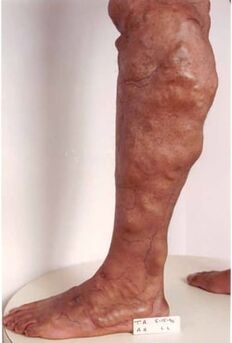
Obstruction of venous outflow leads to a pathological condition called chronic venous insufficiency. At the very beginning of the disease, the appearance of single nodules of dilated vessels may be noted, which, although sometimes painful, do not cause much discomfort. Then there is an increase in the number of varicose veins. The disease develops slowly but steadily. If the first varicose veins appear under the knee, the rate of disease development is higher. If the disease does not stop, then the third stage of venous insufficiency develops gradually. The edema is persistent, the skin on the ankles is dark, the heaviness in the feet is constant, and this can continue even after a night's rest. Often develops varicose veins thrombophlebitis and skin inflammation, eczema and dermatitis. The final stage in the development of varicose veins is the appearance of trophic ulcers.
Thrombophlebitis of varicose veins
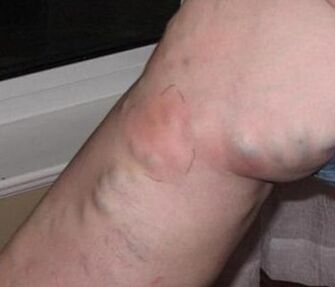
Thrombophlebitis is the most common complication of varicose veins. Thrombophlebitis is an inflammation of the venous wall, the formation of blood clots in the lumen of the vessel. Thrombophlebitis occurs in superficial and deep veins. Thrombophlebitis with varicose veins occurs in 25% of patients and is usually superficial. The cause of thrombophlebitis in varicose veins is very slow blood flow, especially in large nodes. In this case, any factors that increase blood clotting (pregnancy, fever, trauma, sprains, hypothermia and scratches, acute respiratory infections) can lead to the formation of blood clots in varicose veins and its inflammation. Thrombophlebitis occurs in 25% of patients. with varicose veins of the lower extremities. The cause of thrombophlebitis is a slowing of blood flow in varicose veins. Thrombophlebitis can progress to deep vein thrombosis. Chronic venous insufficiency is a painful condition of venous outflow with varicose veins. It is characterized by edema, darkening of the skin, the appearance of trophic ulcers and varicose dermatitis.
Varicose trophic ulcer
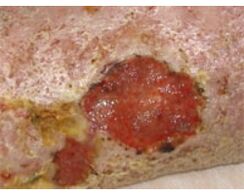
Trophic ulcers are a sign of an extreme degree of chronic venous insufficiency. This creates a long-term incurable condition that occurs with severe disruption of venous flow through deep and superficial veins. It occurs in 1% of the general population and in 20% of patients with venous disease. Sooner or later, one in five patients with untreated varicose veins develops a trophic ulcer. It can develop with both varicose veins and secondary varicose veins. Without the removal of pathological venous discharges, varicose trophic ulcers do not heal or recur. Trophic ulcers with varicose veins occur in most patients and cause severe pain. Modern minimally invasive methods allow to reliably remove varicose trophic ulcers without incisions and pain.
Venous thrombosis and thromboembolism
Pulmonary embolism is a serious complication of venous thrombosis. Varicose veins are an important risk factor for thrombophlebitis and deep venous thrombosis. Thromboembolism leads to the development of severe heart and respiratory failure, with a mortality rate of more than 50%.
Prevention of varicose veins of the lower extremities
Any modern person should understand what varicose veins are in the legs, how to treat and prevent their formation. With hereditary predisposition, factors that contribute to varicose veins should be avoided. The use of venotonic drugs, wearing compression stockings during exercise, periodic examinations by a phlebologist and ultrasound examination of the vessels are indicated.
When working in a reciprocal environment, compression stockings of the 1st compression class, therapeutic exercises, at least 1 hour of daily walks in the open air, medical socks, foot massage and swimming should be used in the workplace. Refuse to use oral contraceptives with a complex inheritance of varicose veins. It is better to follow these simple rules than to treat varicose veins in the legs.
Avoid factors of production during heavy physical work. This requires compression stockings, which are especially prone to varicose veins. Medical knitwear is indicated for all pregnant women, and when prone to varicose veins and thrombophlebitis, special compression stockings are worn for childbirth. In the last weeks of pregnancy, it is recommended that all pregnant women consult a phlebologist and undergo an ultrasound examination of the vessels. This will help reduce the risk of problems with the venous system.
How to treat varicose veins in the legs
"Barbaric" methods of treating varicose veins are becoming a thing of the past, thanks to the emergence of softer and more effective methods that have been successfully used in clinics over the past 10 years.
Sclerotherapy for varicose veins
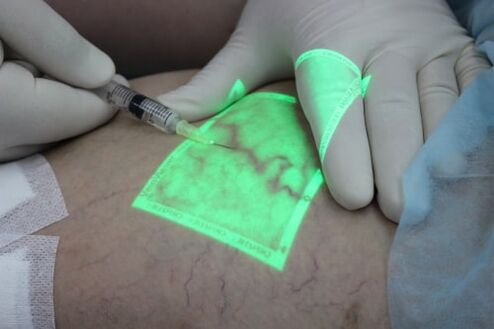
Sclerotherapy is the insertion of a drug into the lumen of a varicose vein that causes the walls to "stick" together with the destruction of the blood vessels. A number of chemicals are used for sclerotherapy, and there have been attempts to treat them with ozone. The appearance of foam sclerotherapy once revolutionized phlebology. For the first time, an effective method of treating varicose veins without major surgery has emerged. Currently, foam sclerotherapy is used to remove medium-diameter varicose veins after laser obliteration of pathological venous discharges. Sclerotherapy is indispensable in the treatment of spider veins and reticular varicose veins, where there are no real competitors.
Laser treatment of varicose veins
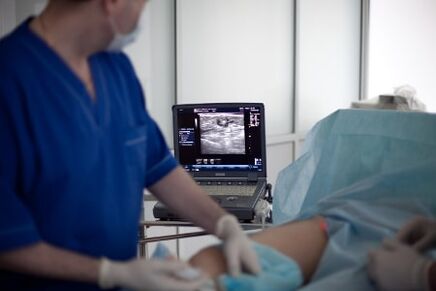
Laser treatment of varicose veins of the lower extremities (EVLT) is the most modern, radical and inexpensive treatment that allows both the treatment of varicose veins in the legs and the elimination of the causes of trophic ulcers. The meaning of laser treatment is thermal heating of the venous wall from the inside and subsequent resorption of the varicose vein. The latest achievement in EVLT is the 1470 nm laser and radial light guide introduced into medical practice by phlebologists. The postoperative period after this technique is completely painless, and the result is superior to other treatment options - the radicality of the laser intervention is at least 98%.
Surgery to remove varicose veins
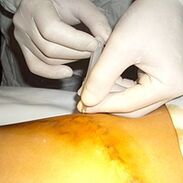
Surgical treatment of varicose veins with removal of the main venous trunks is a thing of the past. The risk of complications of root vein removal forced phlebologists to look for other approaches, which led to the development of laser techniques and other methods of thermal obliteration of blood vessels. However, according to Müller and Varadiy, the modification of classical phlebectomy to microflebectomy allowed for a wonderful combination of laser treatment and the removal of large varicose veins through punctures without incisions and sutures. Varadin's technique saved patients from painful sclerotherapy of large varicose veins. Miniphlebectomy allows you to treat varicose veins of the legs, as well as to remove varicose veins that appear anywhere on the body.
Radiofrequency obliteration of varicose veins
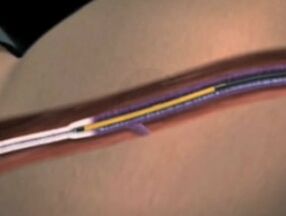
Radiofrequency obliteration (RFO) of varicose veins of the legs is a modern and safe treatment. The method is based on the use of microwave ovens that heat a metal probe that is already the wall of the vessel and destroys the inner membrane. In terms of painlessness, this method is suitable for laser coagulation with lasers with a wavelength of 1470 nm, easy to perform, minimal postoperative pain. However, RFO is significantly lower than laser due to its long-term treatment results. The efficiency of RFO is 85% without duplication. The method is not suitable for the treatment of perforated vessels.
Massage and bath for varicose veins
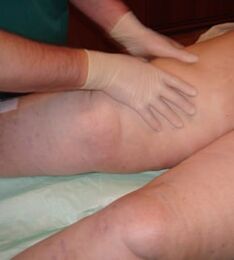
Massage is an active treatment for varicose veins.
All types of modern massage are used, especially in the pathology of the lymphatic and venous systems. Exclusive methods include lymphatic drainage massage technology with a bandage that effectively eliminates chronic venous insufficiency.
In chronic venous insufficiency, massage is used to relieve venous hypertension and post-thrombotic syndrome in varicose veins. The combination of this massage with a bandage allows you to effectively eliminate all the clinical manifestations of the disease.
Bathing with varicose veins, thrombophlebitis or post-thrombotic disease is very dangerous. Any thermal stress can cause blood clots to form in the deep veins and can have all the consequences.
Unfortunately, it is not possible to achieve complete cure of varicose veins without removing venous discharge and varicose veins. Reducing the symptoms associated with venous blood stasis in the legs is quite possible with the help of modern therapy. However, the prevalence of varicose veins and chronic venous insufficiency sometimes makes one want to speculate about the problem. Consider modern treatments and deceptions.
Medications for varicose veins
The goal of drug treatment of venous pathology is to reduce symptoms and prevent complications, but these goals are not easy to achieve. The sheer number of tools available today raises another question: which one to choose? Unfortunately, most of the proposed drugs have very low efficacy, despite the theoretically justified use. This is due to a number of reasons, the most important of which is the low absorption of these drugs by the body. An ideal drug for the treatment of venous insufficiency should affect as many pathogenetic links of chronic venous insufficiency as possible, while having a minimal number of side effects and high absorption by the body. The modern pharmaceutical market offers a large number of venotonic agents. However, they contain similar drugs (plant flavonoids), and therefore the effectiveness of one or the other depends only on the concentration and digestion of the active principle.
You should not expect these medications to eliminate varicose veins, but there may be relief in the legs, reduced edema, and nocturnal cramps.
Creams and gels for varicose veins
Despite the high effectiveness promoted by vendors and manufacturers, creams and gels do not relieve varicose veins and varicose veins do not disappear from them. In the early stages of venous insufficiency, phlebologists do not object to the use of these agents, because their rubbing promotes venous flow as a light massage and has a calming effect on the skin. With advanced forms of venous insufficiency, these creams and ointments can cause dermatitis and allergies and are therefore very harmful. Some drugs are used in the development of acute thrombophlebitis and help reduce the inflammatory process, but varicose veins do not disappear from them. Although leprous shaman products have become very popular due to proper advertising, they have no relation to medicines or even leprosy, and there is no point in expecting them.
Drugs for blood clotting in varicose veins
A frequent complication of varicose veins is thrombophlebitis, especially during pregnancy and the postpartum period. A proven drug for the prevention of blood clots is low-molecular-weight sulfur-containing glycosaminoglycan. Tablets are used in clinics to prevent thrombophlebitis after treatment of varicose veins. They are taken 7 days after laser or radiofrequency intervention.
Compression stockings for varicose veins
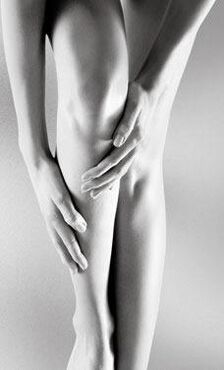
Compression stockings are undoubtedly one of the most effective means of treating venous edema and reducing the rate of chronic venous insufficiency. Compression stockings and socks, invented more than 100 years ago and gaining great popularity in the 20th century and even more in the 21st century, have become an integral part of treatment by a phlebologist. This is due to its effect:
- improving venous and lymph flow from the lower extremities,
- improving microcirculation,
- slow down the course of the disease,
- Prevention of complications of varicose veins (varicothrombophlebitis, trophic disorders),
- prevention of deep vein thrombosis.
How to use compression stockings
So, if you have varicose veins and plan to treat it, you will no doubt use compression stockings for a few days or months (individually) during treatment. If your feet are swollen towards the end of the day after work and you suffer from severe foot syndrome, you can also use compression stockings during the day to prevent these symptoms in the evening. If you have complications of untreated varicose veins - trophic ulcers or thrombophlebitis - you will of course use them without compression to improve the condition of the legs and reduce the unpleasant symptoms.
The fact is that by improving venous flow, compression stockings work to improve the return of venous blood from the legs every second worn, which is certainly not easy for veins that are diseased and contrary to the universal law of gravity. Compression knitwear can safely be called one of the genius inventions of mankind, but in order for it to work for you, a few conditions must be met:
- Compression knitwear is selected individually (according to the standards). The main requirement is to conform to the anatomical profile of the joint and therefore to create the correct pressure gradient.
- Knitwear is selected individually by a doctor (phlebologist). Medical products are marked in mm Hg and are divided into compression classes 1, 2, 3, 4. Each compression class corresponds to a certain pressure. Appropriate compression class is used in different stages of varicose veins or chronic venous insufficiency. Therefore, only a doctor has the right to prescribe and select the right compression stockings, taking into account the nature of the pathology and in accordance with individual standards.
- Weight loss should be medical, not knitwear. Proven brands with RAL certification only.
When do you need knitted clothes for varicose veins?
- correction of "heavy legs" syndrome: reduction of severity, edema, improvement of quality of life;
- during treatment with a phlebologist: after surgery or during the period prescribed by a specialist;
- slow down the development of varicose veins;
- for the treatment of complications of varicose veins (varicothrombophlebitis).
Medical elastic compression is a necessary component of any treatment for varicose veins and chronic venous insufficiency. Thanks to compression therapy, it is possible to completely eliminate swelling and heaviness in the legs and create conditions for any radical treatment of varicose veins. Modern medical knitwear has a high therapeutic effect and excellent aesthetic properties.
Elastic bandages |
Therapeutic shirt |
|---|---|
The establishment of the required pressure is determined by the dressing technique and skills of the physician or patient |
The treatment profile and pressure level indicated during production according to the compression class |
The need for medical involvement in the application of the bandage or the patient's education |
The doctor's presence is limited to the choice of compression class and product type |
Difficulties in providing compression and fixation on the thigh |
Buddha provides effective compression and fixation |
Used for non-standard limb shape |
Individualization is possible with a non-standard form of the organ |
Daily washing causes the dressings to wear out quickly |
Daily washing is required to maintain compression properties |
It should be replaced after a few washes |
Guaranteed protection of compression properties for 6 months |
Possible disturbances of skin water and temperature balance |
The porous closure ensures normal skin temperature and water balance |
Provides low aesthetic features, comfort & convenience |
High aesthetic features, ease of use and flexibility |
Exercises and sports for varicose veins
Strength sports for varicose veins and athletics are possible after the removal of varicose syndrome or in compression stockings of compression class 2-3. Modern treatment is able to normalize the legs with varicose veins, which eliminates all restrictions.
We bring to your attention a set of therapeutic and prophylactic exercises developed by leading specialists. Its regular implementation will help reduce the manifestations of venous insufficiency in the lower extremities, slow the progression of the disease and reduce the risk of life-threatening complications.
- Drainage of leg vessels. Breathe deeply and evenly, lie down with your eyes closed, relax. At the same time, put a few pillows under your feet so that they are raised at an angle of 15-20 °.
- Cycling. Imagine that you are on a bicycle pedal, lying on your back and breathing evenly.
- The exercise consists of several parts, performed slowly and smoothly. Lie on your back, stretch your legs, take a deep breath. Breathe in, bend your right leg, bring your knee to your chest. As you breathe in, straighten your legs vertically upwards. Breathe, lower. Repeat this exercise in turns for each leg.
- Lying on your back, raise your arms across your body, lift your legs vertically. Turn both legs inwards and then outwards at the same time.
- Alternatively, bend and open the legs back and forth at the ankle joint.
- Alternatively, bend and open your toes.
- Stand in one position: legs together, arms along the trunk. After taking a deep breath, slowly rise to your toes, exhale, and return to the starting position.
- Walk in place without lifting your socks.
- Vertical scissors. Lying on your back, arms across your body, breathe evenly, cross your legs in turn.
- Lie on your back and bend your knees without lifting your legs off the ground. Put your hands on your hips. Breathe slowly and lift your head and torso. At the same time, the hands slide to the knees. Breathe slowly, return to starting position.
- Lying on your back, arms along the body, legs at an angle of 15-20 °, hold a small pillow between the legs. Breathe in slowly, bend your back, and pull your hips out of the mattress. Breathe slowly, return to starting position.
- Lie on your back, arms across your body, bend your knees by pressing your feet to the ground. Breathe slowly, inhale. Breathe slowly, inflate your stomach.
- Lying on his back, the legs are raised at an angle of 15-20 °. Bend your right leg and bring your knee to your chest. At the same time, tie your feet tightly with your hands. Slowly lift your leg up. Squeeze your hands and feet and slide them along the calf to knee level. Slowly lower your legs, hands sliding over your thighs. The exercise is repeated for the other leg.
- Standing, feet together, arms across the body, inhale slowly, pull your shoulders back, exhale slowly, relax your shoulders, and lean your head forward.
- Contrasting shower on the feet. Alternate rigid jets of hot and cold water. 5-10 minutes for each foot.













































